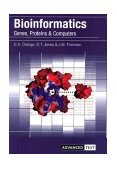 Author(s):
C.A. Orengo, D.T. Jones and J.M.Thornton eds.
Author(s):
C.A. Orengo, D.T. Jones and J.M.Thornton eds.Bioinformatics,
Genes, Proteins and Computers
 Author(s):
C.A. Orengo, D.T. Jones and J.M.Thornton eds.
Author(s):
C.A. Orengo, D.T. Jones and J.M.Thornton eds.
ISBN 1-85996-0545
More Information
Bios Scientific Publishers, Oxford. (July 2003)
Paperback: 298 pages
REVIEW
Bios have three series of titles that they call Instant Notes, Advanced Text
and Advanced Methods. I recently reviewed Instant Notes in Bioinformatics by
D.R. Westhead, J.H. Parish and R.M. Twyman (ref. to previous review). I would
not say that the present volume under the Advanced Text title is more advanced
than the Instant Notes, but it is certainly more thought provoking as you might
expect. The major emphasis is on proteins and the major contribution is by staff
of University College, London and their co-workers.
In her preface, Janet Thornton struggles a little to define bioinformatics.
Her possible succinct definition is: ‘the collecting, archiving, organisation
and interpretation of biological data’. This is too broad as it could be
taken to include Ecology and Systematics (Taxonomy). I prefer her other thoughts:
‘a necessary evil’ … ‘whereby all biologists will become
applied bioinformaticians at some level.’ However, in the very first chapter,
Sylvia Nagl explains exactly what bioinformatics is about under the title ‘Molecular
evolution.’ Organisms and cells contain information largely encoded in
DNA, RNA and proteins. This information is manipulated by complex systems and
is subject to evolutionary change. We can manipulate the same information in
computers and thereby try to understand how these complex systems function in
terms of the processes that are going on. For me, this is the essence of bioinformatics
that distinguishes it from other branches of computational biology or biostatistics.
Chapter 2 on ‘Gene finding’ by J.G. Sgouros and R.M. Twyman is a succinct
account of genetic and physical mapping (strangely lacking from the Instant
Notes book), transcript mapping and the use of bioinformatics to predict regions
of DNA coding for both RNA and proteins. The point is well made that experimental
confirmation of both transcript and protein sequences is essential and that
prediction can only guide these experiments.
Chapters 4-6 concentrate on protein sequences: ‘Sequence comparison methods’
by C. Orengo, ‘Amino acid residue conservation’ by W.S.J. Valdar and
D.T. Jones and ‘Function prediction from protein sequence’ by S.B.
Nagl. The material is well known and well presented and emphasises the fact
that if you already have information about what a protein sequence is doing
it is likely that similar sequences will be doing the same.
Chapters 6-11 relay the same message for protein structures: ‘Protein structure
comparison’ by I. Sillitoe and C. Orengo, ‘Protein structure classifications’
by F. Pearl and C. Orengo, ‘Comparative modeling’ by A.C.R. Martin,
‘Protein structure prediction’ by D.T. Jones, ‘From protein structure
to function’ by A.E. Todd and ‘From structure-based genome annotation
to understanding genes and proteins’ by S.A. Teichmann. I used to find
this area hard to understand, but I think it may have been because the people
explaining it did not understand it very well either. A tremendous amount of
progress has been made in the last 20 years and I recommend this as an excellent
introduction for someone new to the subject. Annabel Todd asks ‘What is
function?’ I think it is pretty clear that function cannot be described
in isolation but only as part of a process in a working system. There must be
examples of the same molecule that does different things according to the system
and the environment in which it finds itself? Sarah Teichmann shows how structural
knowledge of entire proteomes can help us to understand the evolution of protein
families in complete genomes, in multidomain proteins and in their functional
context in cells such as in metabolic pathways.
Chapters 12-16 are based on newer technologies relating to protein-protein interactions,
gene expression and protein expression: ‘Global approaches for studying
protein-protein interaction’ by S.A. Teichmann, ‘Predicting the structure
of protein-biomolecular interactions’ by R.M. Jackson, ‘Experimental
use of DNA arrays’ by P. Kellam and X. Liu, ‘Mining gene expression
data’ by X. Liu and P. Kellam and ‘Proteomics’ by M.P. Weir,
W.P. Blackstock and R.M. Twyman. These are hot topics in bioinformatics but
are less well integrated into the intellectual flow. It might have been better
to put gene expression after gene finding and proteomics before the protein
chapters.
Chapter 17 ‘Data management of biological information’ by N.J. Martin
with a bit of RDBS and SQL is oddly placed, it could have been Chapter 2, or
omitted. Chapter 18 ‘Internet technologies of bioinformatics’ by A.C.R.
Martin could certainly have been omitted, especially Figures 18.1 and 18.2.
There is a brief glossary that seems rather too elementary.
Apart from some minor reservations mentioned, I can strongly recommend this
book to those who require an up-to-date introductory account of established
and emerging procedures for the study of proteins with the help of computer
programs.
Martin Bishop. HGMP, UK Y
TOP
|